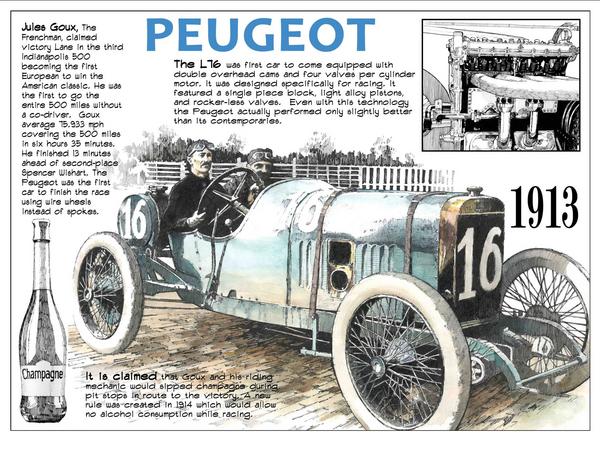- 1890s Cars
- Barney Oldfield Images
- Oldfield - Petersen
- Beer
- Early Auto Industry
- Uniontown - Marci McGuinness
- General Period Clip Art
- Early Race Related Clip Art
- Advertising and Editorial Cartoons
- Early Indianapolis
- IMS Construction
- Indianapolis Speedway
- First IMS Auto Races
- Failed 1909 Air Show
- 1909 IMS Balloon Races
- 1909 IMS Motorcycle Meet
- 1910 Indianapolis Auto Show
- 1913 Indianapolis 500
- 1919 Indianapolis 500
- Joe Dawson
- WWI "500" Winner Draft Cards
- Frank Di Buglione (off the wall art, LLC)
- Gilbert Art
- Carl Graham Fisher
- IMS Hall of Fame Museum
- Alco at 100th Anniversary
- Frederic Matile - Morris Park
- Miami-Fulford Speedway
- Paul Sheedy Collection
- Early Wyoming Racing - 1909 - 1919
- Personalities
- Early Racing Images
- Glidden Tour
- 1909 Cobe Trophy
- Fairmount Park & Belmont Estates
- Early Santa Monica
- Don Radbruch Collection
- Jeroen de Boer Collection 1910
- Jeroen de Boer Collection 1912
- Jeroen de Boer Collection 1913
- Jeroen de Boer Collection 1914
- Georges Boillot
- Story's Indianapolis 500 Cars
- Story's Sports Cars
- Story's Grand Prix Cars
- Old School
- Story's Brickyard Sketchbook
Jules Goux - Peugeot Sketch
Photo Gallery Categories
Search
Featured Article
Image of The Week

This is the third in a series of original art created by David Story and making its online premiere on First Super Speedway. This wonderful art is of Jules Goux sitting in his 1913 Indianapolis 500-winning Peugeot race car. The 1913 race put the word "international" in the Indianapolis 500 Mile International Sweepstakes. For the first time, European manufacturers launched a serious effort to win the "500." This reflected the emergence of the Indianapolis Motor Speedway and the Indianapolis 500 as one of the most important auto races in the world, easily ranking alongside storied European events such as the French Grand Prix and Italy's Targa Florio. Certainly, the Indianapolis 500 had risen to the status of the most important race in America as organizers of the more established Vanderbilt Cup and American Grand Prize failed to conduct those events that year.
Since the first Vanderbilt Cup in 1904, the foreign manufacturers valued at least an annual trip to America to demonstrate their superior products to a growing market. So it was that Peugeot brought two entries with stellar drivers Goux and Paul Zuccarelli and they were joined by three Issotas with Harry Grant, Teddy Tetzlaff and Vincenzo Trucco at the wheels. The other European manufacturer entry came from England's Sunbeam with Frenchman Albert Guyot the driver. Long before air freight the teams shipped their cars on ocean liners - the Isottas arrived on the historically tragic Lusitania - and then by train from the port of New York to Indianapolis. The journey was arduous and hugely frustrating for those waiting. The Isottas did not arrive until two days before race day. The Sunbeam entry was temporarily misplaced in a rail freight yard. Only Peugeot seemed to have their act together. A final point on European manufacturers: There were two Mercedes cars in the race, but both privately owned by Americans.
Coached by Johnny Aitken, a veteran driver, and employee of National Motor Vehicle Company, the manufacturer of the previous year's winning car, Goux drove a calculated race. He paced himself while a more aggressive Bob Burman led much of the early going, pushing his American Keeton racer until its Miller carburetor failed. Whether Burman's onslaught induced mechanical failure or not is conjecture, but it is easy to argue that the Peugeot was the class of the field and could boast of precision engineering and speed. Perhaps the most colorful storyline of the race was Goux's consumption of wine. The legend swelled through the years as some told tales of him drinking as many as six bottles. The reality is that he probably consumed just a few mouthfuls and used the vino mostly for mouthwash. The debate too is whether the beverage was champagne or wine but regardless any drinking of alcohol by a driver in an auto race is outrageous by today's standards - and surprisingly more common in those days than many realize.
Check out David Story's other sketches of Ray Harroun and Joe Dawson elsewhere on First Super Speedway.
| Attachment | Size |
|---|---|
| 1913 email version.jpg | 410.95 KB |
